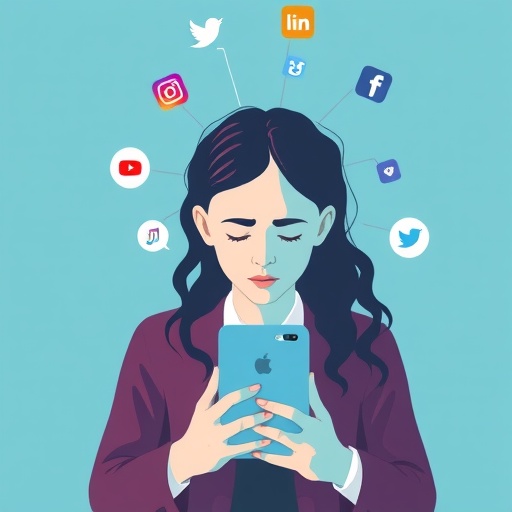In an era where social media platforms have become virtually inseparable from daily life, understanding their psychological impacts is critically important. A recent study conducted by Nurmala, Muthmainnah, Hsieh, and colleagues offers fresh and nuanced insights into how problematic social media use correlates with mental distress among university students in Indonesia and Taiwan. The researchers distinguished between problematic generalized social media use and problematic use of a specific platform, namely YouTube, revealing complex and differentiated patterns of mental health outcomes.
This study arrives at a pivotal moment when youth mental health concerns are climbing internationally, largely intersecting with digital media consumption behaviors. The research underscores that not all social media usage carries the same psychological risks. Rather, problematic generalized use—characterized by excessive engagement across multiple platforms—exerts different mental health effects compared to specific problematic use focused on one platform, such as YouTube. This differentiation is critical for clinical and policy interventions targeting digital wellbeing.
By employing rigorous cross-cultural methodologies, the researchers were able to compare Indonesian and Taiwanese university students, two populations with rich yet distinct digital ecosystems. Taiwan’s digital landscape, known for its advanced infrastructure and high internet penetration, contrasts with Indonesia’s rapidly expanding but uneven technological adoption. Such comparative analysis provides a vital lens to explore how socio-cultural factors modulate the relationships between digital habits and psychological wellbeing.
.adsslot_TleDBEyHXr{width:728px !important;height:90px !important;}
@media(max-width:1199px){ .adsslot_TleDBEyHXr{width:468px !important;height:60px !important;}
}
@media(max-width:767px){ .adsslot_TleDBEyHXr{width:320px !important;height:50px !important;}
}
ADVERTISEMENT
The study utilized standardized psychometric tools to quantify levels of problematic social media use and associated mental distress symptoms. Importantly, mental distress was operationalized through measures of anxiety, depression, and stress, capturing a broad spectrum of psychological suffering. The data revealed that students exhibiting problematic generalized social media use consistently reported higher levels of mental distress indicators.
Intriguingly, the study found that problematic YouTube use manifested distinct psychological correlates compared to generalized social media engagement. Unlike platforms designed primarily for interactive social networking, YouTube—despite its social elements—functions mainly as a content consumption medium. Excessive YouTube use was associated with unique patterns of emotional and cognitive distress, suggesting that immersion in passive content viewing and algorithm-driven recommendation systems may have particular psychological effects.
The research delves into the concept of “problematic use” by framing it not merely as high-frequency usage but as usage that interferes with daily functioning and emotional wellbeing. This distinction is pivotal, shifting the conversation from simplistic usage metrics toward qualitative evaluations of digital behavior. Problematic generalized use often encompasses multitasking across applications, incessant social comparison, and compulsive checking, all of which can undermine mental health resilience.
The implications of these findings are profound in the context of preventive mental health strategies. Digital literacy programs and campus mental health services must tailor their approaches to differentiate between broad, generalized social media overuse and platform-specific compulsions. Developing targeted interventions rooted in understanding the unique affordances and psychological impacts of each platform is essential for effective mental health promotion.
Neurobiologically, the study’s findings resonate with emerging evidence that different types of social media use activate distinct neural circuits. Generalized social media use may predominantly engage reward and social cognition networks, while prolonged YouTube consumption could affect attention and default mode networks differently. Such diverging neural engagement may explain variances in symptoms such as anxiety versus disengagement or depressive rumination.
From a technical standpoint, the researchers leveraged sophisticated statistical modeling, including structural equation modeling, to dissect the pathways linking social media use styles to mental distress. They controlled for confounding variables such as age, gender, academic stress, and baseline mental health status, enhancing the robustness of their conclusions. The models suggested partial mediation effects, wherein problematic use partially explained the relationship between underlying psychological vulnerabilities and mental distress outcomes.
Culturally, the study illuminated how societal norms and digital regulations shape usage patterns. In Indonesia, peer influences and collectivist values modulate social media engagement, potentially intensifying generalized social media overuse. In contrast, Taiwanese students reported greater tendencies toward individualized consumption of YouTube content, reflecting nuanced differences in cultural attitudes toward digital media.
Importantly, the study also raised critical questions about algorithmic design and platform responsibility. YouTube’s recommendation algorithms were implicated in reinforcing compulsive viewing behaviors that contribute to emotional exhaustion and withdrawal symptoms. These technical design elements underscore the ethical imperatives for platform developers to consider mental health outcomes in their product architectures.
The researchers advocated for integrative frameworks in future studies, combining psychometrics, neuroimaging, and big data analytics to capture the multi-dimensionality of social media’s psychological impact. Such interdisciplinary approaches will be necessary to unravel how evolving digital content ecosystems interact dynamically with mental health across diverse populations.
Clinicians and mental health practitioners are urged to incorporate assessments of digital behaviors into routine evaluations, recognizing the heterogeneity in social media use patterns. Differentiating between generalized and platform-specific problematic use can refine diagnostic precision and guide personalized intervention plans, potentially incorporating digital detoxification and cognitive-behavioral strategies tailored to online habits.
In sum, this landmark comparative study not only advances academic understanding but also catalyzes urgent action in public health domains. As social media platforms continue to embed themselves in the social fabric, elucidating the nuanced and complex connections between digital behavior and mental wellbeing remains a paramount challenge and opportunity for science and society alike.
Subject of Research: Problematic social media use and mental distress among university students in Indonesia and Taiwan, with a focus on differences between generalized social media use and specific problematic YouTube use.
Article Title: Problematic Social Media Use and Mental Distress among Indonesian and Taiwanese University Students: Comparing Problematic Generalized Use and Specific Problematic YouTube Use.
Article References: Nurmala, I., Muthmainnah, M., Hsieh, GJ. et al. Problematic Social Media Use and Mental Distress among Indonesian and Taiwanese University Students: Comparing Problematic Generalized Use and Specific Problematic YouTube Use. Int J Ment Health Addiction (2025). https://doi.org/10.1007/s11469-025-01517-y
Image Credits: AI Generated
Tags: cross-cultural study on social mediadigital ecosystems and wellbeingdigital wellbeing interventionsexcessive social media engagementIndonesia Taiwan student comparisonplatform-specific social media use effectsproblematic social media usepsychological effects of social mediasocial media impact on mental healthuniversity students mental distressyouth mental health trendsYouTube and mental health





